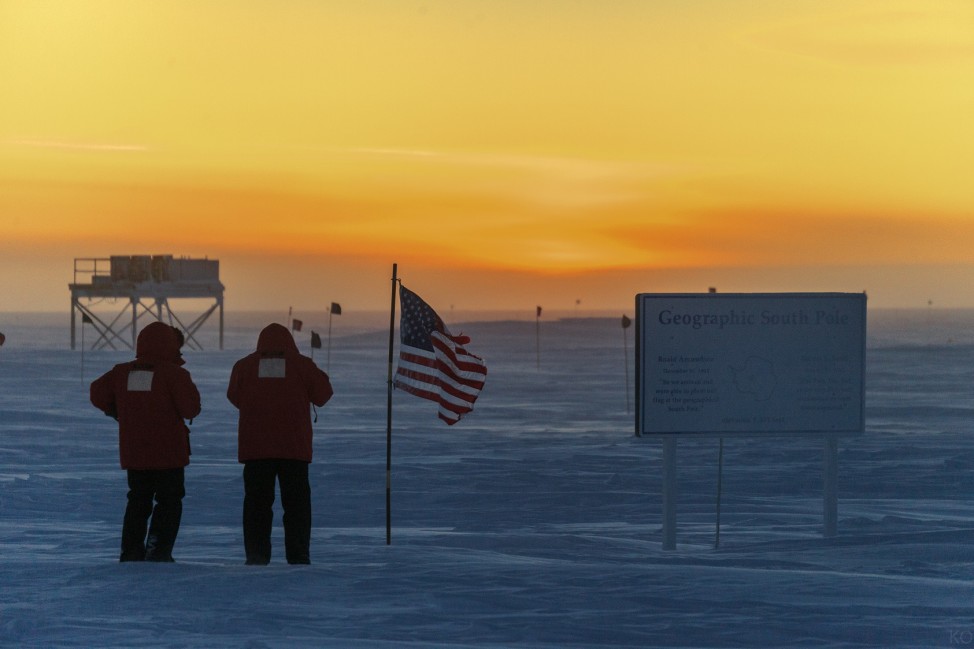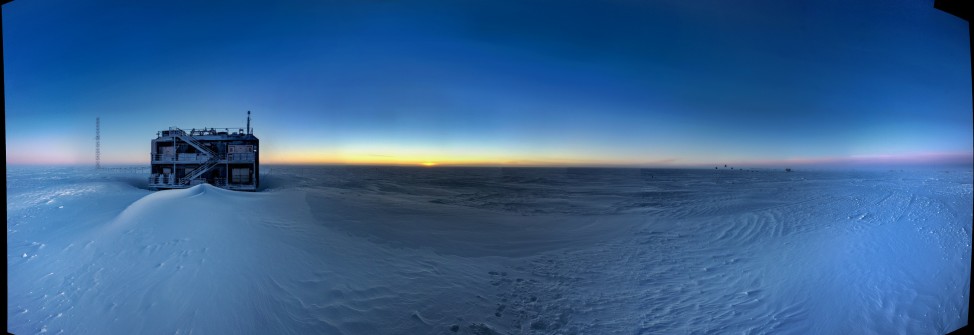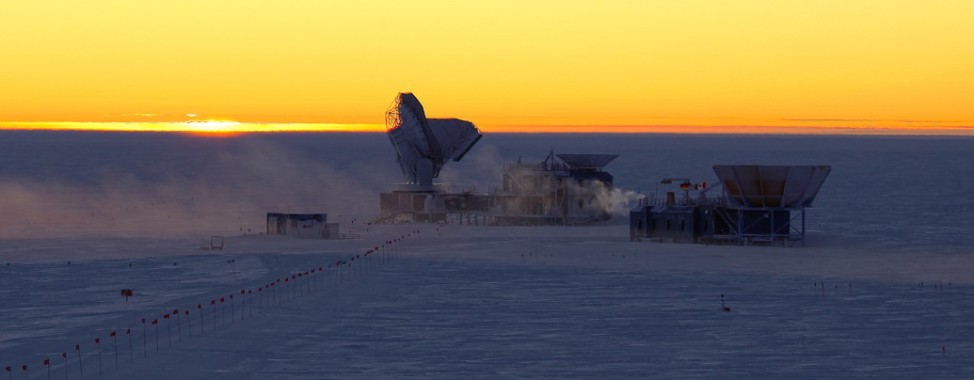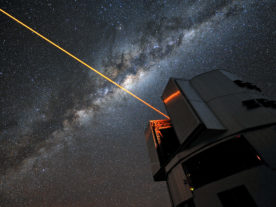
Two Polies brave the frigid temperatures to snap a few photos of the sunset. When conditions are as cold as they are at the moment, camera batteries only last a few minutes. (Photo by Kyle Obrock)
SOUTH POLE JOURNAL
Refael Klein blogs about his year
working and living at the South Pole. Read his earlier posts here.
It is the solstice. The sun is half set. For the moment, it is perfectly bisected by the horizon. It is the same sun seen in Hawaii travel brochures and Kinkade paintings. It is the same sun that has sat above my head since October, and the same sun that will rise for you this morning and set for you this evening.
Perhaps anywhere else, it would be a kitsch image. The immutable laws of nature: a dependable 24-hour cycle, 365 ups and downs a year, an image so easy to capture and reproduce that it seems to no longer hold any aesthetic value; an icon used to convey the incredible and the exotic, but almost always representing the opposite — the mundane and the accessible: Walmart, Snapple, Days inn.
Now, the sun has set a little lower. It only took a few seconds, but at this very moment more of it sits below the horizon than above it. The horizon is deep orange, and pink light washes out in every direction over the polar plateau. It’s a fiery landscape. Outside it looks warmer then it is. If I had to guess, I’d say minus 30 Fahrenheit (minus 34 Celsius), but really it is much colder — minus 80 Fahrenheit (minus 62 Celsius), the coldest it’s been all year.

At 12:30 a.m., an early morning at ARO. When the sun sets, we will remove our solar radiation equipment from the roof. (Photo by Kyle Obrock)
The sun rises and sets only once a year at the South Pole, rising in September and disappearing below the horizon in March, which means we experience up to 24 hours of sunlight in the summer and 24 hours of darkness in the winter.
No one really knows exactly when the sun will disappear. Atmospheric conditions can make it seem like it is sitting higher than it really is. Even if it has sunk completely below the horizon, a sliver of it may remain visible for a little longer. Our best guess is that the sun will drop out of sight sometime in the next six days.
Not knowing when the sun will set is a bit unnerving. It could be here tomorrow when I wake up or it could be gone. Maybe it will vanish while I’m skimming through my email or taking a shower. It could disappear in a green flash while I’m making myself a cup of mint tea. The whole ordeal is making me feel a little manic. It’s like watching a nurse prep a blood test for your yearly physical. You don’t know when you will get stuck, but you will, and do they want to you inhaling or exhaling when it happens, sitting up or lying down?

An orange sky over the dark sector telescopes. As day turns to a 6-month-long night, the experiments will start up in earnest. (Photo by Christian Krueger)
I’d like to be on the rooftop of the Atmospheric Research Observatory (ARO) when the sun sets, with a cup of hot coffee held between my mittened hands. I’d like to watch the last inch of it rock on the horizon, like a gymnast standing at the end of a balance beam ready to dismount and then, with breath held, watch it slowly sink away until the horizon is nothing more than a perfectly straight, black line, and all that separates me from winter is a few days of dusk.
The sun has set even lower. It is darker out now than when I first began writing this entry. Only a minute has passed, but it is noticeably darker. The pink on the ice cap is more muted, the horizon more red than orange. Above the sun, the sky follows a perfect gradation from orange to blue to dark blue. It looks colder than it did, though I still wouldn’t peg it at minus 80 Fahrenheit because there’s still too much color flooding the landscape.
When the sun sets, it will be gone for six months. What to do with my final days? Ski, run, hike? It’s far too frigid for any of that. When the wind is blowing like it has been lately, it’s almost painful to be outside. I can only remove my fogged goggles for a few seconds before my forehead and the bridge of my nose go numb. It still looks warmer than it really is, but I know at this point to trust the daily weather report more than my own desires.
More South Pole Diaries
Isolated and Alone, South Pole Workers Face Unexpected Emergencies
South Polies Tackle Last-minute Preps to Survive Brutal Winter
South Pole Summer Camp Helps Combat Winter Blues
Stranded Until Spring: Last Flight Leaves South Pole Before Winter Hits
In Giant Parkas, Rank Is Less Apparent






















Rafael: Hopefully, these are the last days of sunshine, not your last days. Relax, you’re going to be fine.
John N. Roseberg, MD
W/O Physician 1981-82
Ware does one volunteer for service at your base, It looks like a fun interesting place to spend a year or more. I spent two years in Alaska at fort Greeley and Fairbanks. The cold makes for a warmer home life and better friends.
Hi Rafael- I am in a class taught by Bette Schneiderman and she informed us of your blog and told us to check it out. Greetings from New York! These pictures are amazing!!! Full days of darkness can’t be fun but this is an experience most people will never know. Enjoy and good luck!
Another New York graduate student here! What stunning photographs. As someone who gets depressed after a few rainy days, I could not imagine what you will be experiencing over the next six months. I wish you well and look forward to reading about your time at the South Pole.
Ashley,
Most people at the Pole deal with some type of seasonal affective disorder–but we try our best to combat it with ample vitamin D, and regular use of full spectrum lights.
Cheers,
RK
Your pictures are amazing. I cannot fathom being somewhere that it is so cold your camera battery only lasts for a few minutes. Keep sharing!
Hi Rafael – I am another one of Bette Schneiderman’s students from her graduate program. I enjoyed reading many of your blogs, and I think what you are doing is great. Your photographs are amazing and make this look like such a beautiful place, despite the freezing cold. Good luck on your six months of winter!
Another graduate student from the program in New York! I really enjoyed this post! The images are beautiful and the way you described your experiences was extremely captivating. You really have a way of immersing your audience! Enjoy your experiences!
Hi Rafael – I am another graduate student from New York. I couldn’t imagine what it would feel like to live in darkness for the next six months, or feeling so cold that my face would go numb within seconds of it being exposed. It must be an amazing experience to live through and I wish you the best of luck in your endeavors.
This is so interesting to see how there is 24 hours sunlight in the winter and 24 hours of darkness in the summer! I can’t even begin to wrap my head around that! It must be amazing to experience.
Your pictures you have posted are truly mesmerizing and your writing is so powerful. You have given us a “feeling” for what you are experiencing and your blogs have been amazing to read. I am not sure how I would feel to experience 24 hours of darkness but am very curious to see how you make out your descriptions of it! All the best with this experience!
Good afternoon from here in New York! It is remarkable what you are doing and experiencing in the South Pole. The imagery you use to describe the sun setting is impeccable and makes me feel as if I am there as well. Good luck with all of your research!